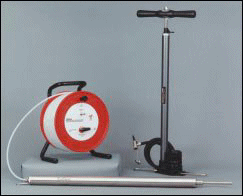
Vol. 8 No. 3
Back to Newsletters

Phase Relationships
The porous
media, or soil, can be either a two-phase or three-phase composition.
When you have dry soil, only the solid soil particles and air within
the pores are present, resulting in a two-phase media. Obviously, when
liquid (i.e. water) is added to the media, it is then a three-phase
composition.
There are
several parameters associated with phase relationships. This
newsletter will present the equations, and calculators for the phase
relationship parameters:
-
moisture
content
-
degree of
saturation
-
void ratio
-
porosity
MOISTURE
CONTENT
Moisture
content is defined as the ratio of the mass of water to the mass of
solids in the soil:
w = Mw/Ms
DEGREE OF
SATURATION
The degree of
saturation is defined as the ratio of the volume of water to the total
volume of void space:
Sr=Vw/Vv
VOID RATIO
Void ratio is
defined as the ratio of the volume of the voids to the total volume of
the soil:
e=Vv/Vs
POROSITY
Porosity is the
ratio of the volume of voids to the total volume of the soil:
n=Vv/V
Many of these
parameters are used in hydrogeological studies every day, such as
porosity and moisture content. Depending on the
make up of the subsurface, such as the stratigraphy and lithology, you
may encounter several different values for the above parameters with
depth. Differentiating between these units can often be
difficult, however, equipment is available for partitioning off
sections for sampling, such as the
Solinst Discrete Interval Sampler.

Phase Relationship
Calculators
**In all calculators keep the
units consistent**
Moisture Content
Return
to top of Page

Discrete Interval
Sampler


The Solinst Discrete
Interval Sampler is a stainless steel sampler, with LDPE tubing mounted on the
convenient Solinst reel. The reel has a pressure attachment for the high
pressure hand pump, and a pressure/vent switch which is used to apply and
release the pressure on the sampler. A sample release device is included
with each Discrete Interval Sampler.
Applications
The Discrete
Interval Sampler has numerous applications, including:
-
collecting
samples from distinct levels or points of inflow
-
profiling
open bodies of water, open boreholes and screened wells
-
obtaining
truly representative water samples from below floating product, or for
obtaining samples of the product itself
Advantages
There are
many advantages to using the Discrete Interval Sampler, including:
-
no mixing of
water from different levels or units
-
minimal
disturbance of the water
-
high quality
samples
-
easy
disassembly for decontamination
-
avoids
purging and disposal of purge water
For more info click here:
Discrete Interval Sampler
To purchase click here:
Order
Online
Return
to top of Page
|

